Sphingosine 1-phosphate lyase deficiency disrupts lipid homeostasis in liver
- PMID: 20097939
- PMCID: PMC2856294
- DOI: 10.1074/jbc.M109.081489
Sphingosine 1-phosphate lyase deficiency disrupts lipid homeostasis in liver
Abstract
The cleavage of sphingoid base phosphates by sphingosine-1-phosphate (S1P) lyase to produce phosphoethanolamine and a fatty aldehyde is the final degradative step in the sphingolipid metabolic pathway. We have studied mice with an inactive S1P lyase gene and have found that, in addition to the expected increase of sphingoid base phosphates, other sphingolipids (including sphingosine, ceramide, and sphingomyelin) were substantially elevated in the serum and/or liver of these mice. This latter increase is consistent with a reutilization of the sphingosine backbone for sphingolipid synthesis due to its inability to exit the sphingolipid metabolic pathway. Furthermore, the S1P lyase deficiency resulted in changes in the levels of serum and liver lipids not directly within the sphingolipid pathway, including phospholipids, triacyglycerol, diacylglycerol, and cholesterol. Even though lipids in serum and lipid storage were elevated in liver, adiposity was reduced in the S1P lyase-deficient mice. Microarray analysis of lipid metabolism genes in liver showed that the S1P lyase deficiency caused widespread changes in their expression pattern, with a significant increase in the expression of PPARgamma, a master transcriptional regulator of lipid metabolism. However, the mRNA expression of the genes encoding the sphingosine kinases and S1P phosphatases, which directly control the levels of S1P, were not significantly changed in liver of the S1P lyase-deficient mice. These results demonstrate that S1P lyase is a key regulator of the levels of multiple sphingolipid substrates and reveal functional links between the sphingolipid metabolic pathway and other lipid metabolic pathways that may be mediated by shared lipid substrates and changes in gene expression programs. The disturbance of lipid homeostasis by altered sphingolipid levels may be relevant to metabolic diseases.
Figures
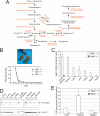
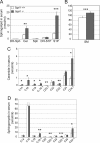
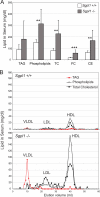
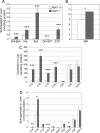

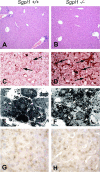


Similar articles
-
Sphingosine 1-phosphate (S1P) lyase deficiency increases sphingolipid formation via recycling at the expense of de novo biosynthesis in neurons.J Biol Chem. 2012 Mar 16;287(12):9128-36. doi: 10.1074/jbc.M111.302380. Epub 2012 Jan 30. J Biol Chem. 2012. PMID: 22291021 Free PMC article.
-
Epigenetic regulation of pro-inflammatory cytokine secretion by sphingosine 1-phosphate (S1P) in acute lung injury: Role of S1P lyase.Adv Biol Regul. 2017 Jan;63:156-166. doi: 10.1016/j.jbior.2016.09.007. Epub 2016 Sep 29. Adv Biol Regul. 2017. PMID: 27720306 Free PMC article. Review.
-
Sphingosine-1-phosphate lyase deficiency produces a pro-inflammatory response while impairing neutrophil trafficking.J Biol Chem. 2011 Mar 4;286(9):7348-58. doi: 10.1074/jbc.M110.171819. Epub 2010 Dec 20. J Biol Chem. 2011. PMID: 21173151 Free PMC article.
-
Dual functions of the trans-2-enoyl-CoA reductase TER in the sphingosine 1-phosphate metabolic pathway and in fatty acid elongation.J Biol Chem. 2014 Sep 5;289(36):24736-48. doi: 10.1074/jbc.M114.571869. Epub 2014 Jul 21. J Biol Chem. 2014. PMID: 25049234 Free PMC article.
-
Sphingosine phosphate lyase insufficiency syndrome (SPLIS): A novel inborn error of sphingolipid metabolism.Adv Biol Regul. 2019 Jan;71:128-140. doi: 10.1016/j.jbior.2018.09.004. Epub 2018 Sep 25. Adv Biol Regul. 2019. PMID: 30274713 Free PMC article. Review.
Cited by
-
The apolipoprotein m-sphingosine-1-phosphate axis: biological relevance in lipoprotein metabolism, lipid disorders and atherosclerosis.Int J Mol Sci. 2013 Feb 25;14(3):4419-31. doi: 10.3390/ijms14034419. Int J Mol Sci. 2013. PMID: 23439550 Free PMC article.
-
Sphingosine-1-Phosphate (S1P) Lyase Inhibition Aggravates Atherosclerosis and Induces Plaque Rupture in ApoE-/-Mice.Int J Mol Sci. 2022 Aug 24;23(17):9606. doi: 10.3390/ijms23179606. Int J Mol Sci. 2022. PMID: 36077004 Free PMC article.
-
Sphingosine 1-Phosphate Lyase in the Developing and Injured Nervous System: a Dichotomy?Mol Neurobiol. 2023 Dec;60(12):6869-6882. doi: 10.1007/s12035-023-03524-3. Epub 2023 Jul 28. Mol Neurobiol. 2023. PMID: 37507574 Free PMC article. Review.
-
Mouse Liver Compensates Loss of Sgpl1 by Secretion of Sphingolipids into Blood and Bile.Int J Mol Sci. 2021 Sep 30;22(19):10617. doi: 10.3390/ijms221910617. Int J Mol Sci. 2021. PMID: 34638955 Free PMC article.
-
S1P Lyase Regulation of Thymic Egress and Oncogenic Inflammatory Signaling.Mediators Inflamm. 2017;2017:7685142. doi: 10.1155/2017/7685142. Epub 2017 Dec 3. Mediators Inflamm. 2017. PMID: 29333002 Free PMC article. Review.
References
Publication types
MeSH terms
Substances
Grants and funding
LinkOut - more resources
Full Text Sources
Other Literature Sources
Molecular Biology Databases

